

#Chinese espionage techniques windows#
This Advisory focuses on a tactic called Living off the land, or LOTL, a set of techniques used by cyber actors to maintain anonymity within IT infrastructures by abusing tools already present in the environment such as PowerShell, Windows Management Instrumentation (WMI), and file transfer protocol (FTP) clients. Review the Joint Cybersecurity Advisory on People's Republic of China State-Sponsored Cyber Actor Living off the Land to Evade Detection.As a starting point, organizations should: government and around the world provide timely and actionable information about the PRC cyber threat to help organizations prioritize the most effective cybersecurity measures. In this context, every organization must take urgent action to understand and address known tactics, techniques, and procedures (TTPs) used by PRC cyber actors – including efforts to detect and prevent intrusions and respond to and recover from incidents, particularly by investing in the operational resilience of essential services. China almost certainly is capable of launching cyber attacks that could disrupt critical infrastructure services within the United States, including against oil and gas pipelines, and rail systems." China’s cyber pursuits and its industry’s export of related technologies increase the threats of aggressive cyber operations against the U.S. government should invest in ways to manage the situation that are consistent with our values and legitimate security concerns.The Office of the Director of National Intelligence’s 2023 Annual Threat Assessment makes clear the cyber threat posed by the People’s Republic of China (PRC): “China probably currently represents the broadest, most active, and persistent cyber espionage threat to U.S. Its current reliance on external models to supplement indigenous research is effective, and the alternative (liberalization) is too risky for China.Ĭhina’s legal and extralegal technology transfers are likely to continue. We have low confidence that any combination of persuasion or disincentives will cause China to abandon its idiosyncratic transfer practices.

The belief that liberal democracies, and the United States especially, are endowed with a creative advantage is not well supported by evidence. Just as important, creativity is multi-faceted and implemented by different cultures in different ways. China is building indigenous S&T capacity and can innovate on its own terms, while taking account of global trends to move to new stages of novel development. William Hannas and Huey-Meei ChangĬhina’s reputation as a copycat is overstated and the formulation itself is simplistic.


 0 kommentar(er)
0 kommentar(er)
